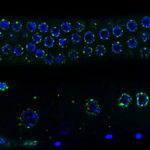Lien vers Pubmed [PMID] – 26650393
PLoS ONE 2015;10(12):e0144706
The ANRS-EP38-IMMIP study aimed to provide a detailed assessment of the immune status of perinatally infected youths living in France. We studied Gag-specific CD4 and CD8 T-cell proliferation and the association between the proliferation of these cells, demographic factors and HIV disease history. We included 93 youths aged between 15 and 24 years who had been perinatally infected with HIV. Sixty-nine had undergone valid CFSE-based T-cell proliferation assays. Gag-specific proliferation of CD4 and CD8 T cells was detected in 12 (16%) and 30 (38%) patients, respectively. The Gag-specific proliferation of CD4 and CD8 T cells was more frequently observed in black patients than in patients from other ethnic groups (CD4: 32% vs. 4%, P = 0.001; CD8: 55% vs. 26%, P = 0.02). Among aviremic patients, the duration of viral suppression was shorter in CD8 responders than in CD8 nonresponders (medians: 54 vs. 20 months, P = 0.04). Among viremic patients, CD8 responders had significantly lower plasma HIV RNA levels than CD8 nonresponders (2.7 vs. 3.7 log10 HIV-RNA copies/ml, P = 0.02). In multivariate analyses including sex and HIV-1 subtype as covariables, Gag-specific CD4 T-cell proliferation was associated only with ethnicity, whereas Gag-specific CD8 T-cell proliferation was associated with both ethnicity and the duration of viral suppression. Both CD4 and CD8 responders reached their nadir CD4 T-cell percentages at younger ages than their nonresponder counterparts (6 vs. 8 years, P = 0.04 for both CD4 and CD8 T-cell proliferation). However, these associations were not significant in multivariate analysis. In conclusion, after at least 15 years of HIV infection, Gag-specific T-cell proliferation was found to be more frequent in black youths than in patients of other ethnic groups, despite all the patients being born in the same country, with similar access to care.




